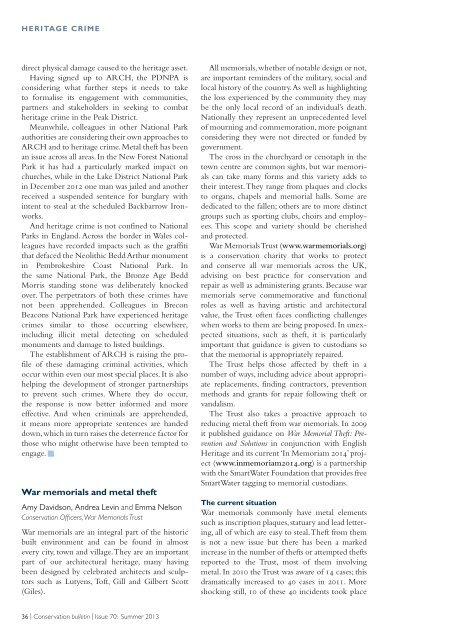Conservation Bulletin 70 | PDF - English Heritage
Conservation Bulletin 70 | PDF - English Heritage
Conservation Bulletin 70 | PDF - English Heritage
You also want an ePaper? Increase the reach of your titles
YUMPU automatically turns print PDFs into web optimized ePapers that Google loves.
HERITAGE CRIME<br />
direct physical damage caused to the heritage asset.<br />
Having signed up to ARCH, the PDNPA is<br />
considering what further steps it needs to take<br />
to formalise its engagement with communities,<br />
partners and stakeholders in seeking to combat<br />
heritage crime in the Peak District.<br />
Meanwhile, colleagues in other National Park<br />
authorities are considering their own approaches to<br />
ARCH and to heritage crime. Metal theft has been<br />
an issue across all areas. In the New Forest National<br />
Park it has had a particularly marked impact on<br />
churches, while in the Lake District National Park<br />
in December 2012 one man was jailed and another<br />
received a suspended sentence for burglary with<br />
intent to steal at the scheduled Backbarrow Ironworks.<br />
And heritage crime is not confined to National<br />
Parks in England. Across the border in Wales colleagues<br />
have recorded impacts such as the graffiti<br />
that defaced the Neolithic Bedd Arthur monument<br />
in Pembrokeshire Coast National Park. In<br />
the same National Park, the Bronze Age Bedd<br />
Morris standing stone was deliberately knocked<br />
over. The perpetrators of both these crimes have<br />
not been apprehended. Colleagues in Brecon<br />
Beacons National Park have experienced heritage<br />
crimes similar to those occurring elsewhere,<br />
including illicit metal detecting on scheduled<br />
monuments and damage to listed buildings.<br />
The establishment of ARCH is raising the profile<br />
of these damaging criminal activities, which<br />
occur within even our most special places. It is also<br />
helping the development of stronger partnerships<br />
to prevent such crimes. Where they do occur,<br />
the response is now better informed and more<br />
effective. And when criminals are apprehended,<br />
it means more appropriate sentences are handed<br />
down, which in turn raises the deterrence factor for<br />
those who might otherwise have been tempted to<br />
engage. ■<br />
War memorials and metal theft<br />
Amy Davidson, Andrea Levin and Emma Nelson<br />
<strong>Conservation</strong> Officers,War Memorials Trust<br />
War memorials are an integral part of the historic<br />
built environment and can be found in almost<br />
every city, town and village.They are an important<br />
part of our architectural heritage, many having<br />
been designed by celebrated architects and sculptors<br />
such as Lutyens, Toft, Gill and Gilbert Scott<br />
(Giles).<br />
All memorials, whether of notable design or not,<br />
are important reminders of the military, social and<br />
local history of the country.As well as highlighting<br />
the loss experienced by the community they may<br />
be the only local record of an individual’s death.<br />
Nationally they represent an unprecedented level<br />
of mourning and commemoration, more poignant<br />
considering they were not directed or funded by<br />
government.<br />
The cross in the churchyard or cenotaph in the<br />
town centre are common sights, but war memorials<br />
can take many forms and this variety adds to<br />
their interest.They range from plaques and clocks<br />
to organs, chapels and memorial halls. Some are<br />
dedicated to the fallen; others are to more distinct<br />
groups such as sporting clubs, choirs and employees.<br />
This scope and variety should be cherished<br />
and protected.<br />
War Memorials Trust (www.warmemorials.org)<br />
is a conservation charity that works to protect<br />
and conserve all war memorials across the UK,<br />
advising on best practice for conservation and<br />
repair as well as administering grants. Because war<br />
memorials serve commemorative and functional<br />
roles as well as having artistic and architectural<br />
value, the Trust often faces conflicting challenges<br />
when works to them are being proposed. In unexpected<br />
situations, such as theft, it is particularly<br />
important that guidance is given to custodians so<br />
that the memorial is appropriately repaired.<br />
The Trust helps those affected by theft in a<br />
number of ways, including advice about appropriate<br />
replacements, finding contractors, prevention<br />
methods and grants for repair following theft or<br />
vandalism.<br />
The Trust also takes a proactive approach to<br />
reducing metal theft from war memorials. In 2009<br />
it published guidance on War Memorial Theft: Prevention<br />
and Solutions in conjunction with <strong>English</strong><br />
<strong>Heritage</strong> and its current ‘In Memoriam 2014’ project<br />
(www.inmemoriam2014.org) is a partnership<br />
with the SmartWater Foundation that provides free<br />
SmartWater tagging to memorial custodians.<br />
The current situation<br />
War memorials commonly have metal elements<br />
such as inscription plaques, statuary and lead lettering,<br />
all of which are easy to steal.Theft from them<br />
is not a new issue but there has been a marked<br />
increase in the number of thefts or attempted thefts<br />
reported to the Trust, most of them involving<br />
metal. In 2010 the Trust was aware of 14 cases; this<br />
dramatically increased to 40 cases in 2011. More<br />
shocking still, 10 of these 40 incidents took place<br />
36 | <strong>Conservation</strong> bulletin | Issue <strong>70</strong>: Summer 2013

















